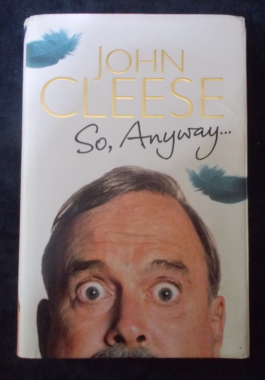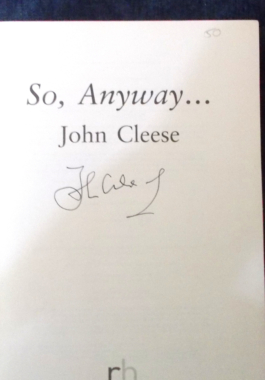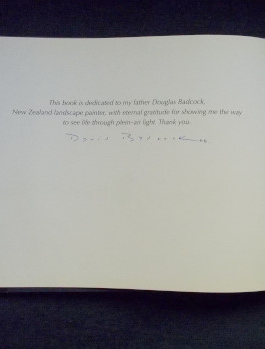Eight centuries of women's correspondence: from Eloise to Abelard, Elizabeth I to Erik of Sweden, Mary Wollstonecraft to Talleyrand; Jane Austen, George Sand, Louisa May Alcott, Virginia Woolf, Anais Nin and many others. All the topics of interest to women are covered and organised by subject matter, covering various topics from politics, work and war, childhood, love and sexual passion. This volume reveals the depth, breadth and diversity of women's lives through the ages. It provides an opportunity to read the real words of real women, in their own intimate language. A fascinating overview of eight hundred years demonstrating what has changed -and what has not.
-

-
 Vita Sackville-West: aristocrat, literary celebrity, devoted wife, famous lover of Virginia Woolf, recluse - and iconoclast who defied categorisation. Here are all the triumphs and contradictions of Vita's extraordinary life: her lonely childhood at Knole, her affectionate but ‘open' marriage to Harold Nicolson (during which both husband and wife energetically pursued homosexual affairs, Vita most famously with Virginia Woolf), her literary successes and disappointments and the famous gardens the couple created at Sissinghurst. Her aristocratic background gave her a penchant for costume, play-acting and rebellion which she took to the artistic vanguard of modern Britain. But behind Vita's public achievements and revolutions was an often troubled persona which heroically resisted compromise on every level. Illustrated with black and white and colour archival photographs.
Vita Sackville-West: aristocrat, literary celebrity, devoted wife, famous lover of Virginia Woolf, recluse - and iconoclast who defied categorisation. Here are all the triumphs and contradictions of Vita's extraordinary life: her lonely childhood at Knole, her affectionate but ‘open' marriage to Harold Nicolson (during which both husband and wife energetically pursued homosexual affairs, Vita most famously with Virginia Woolf), her literary successes and disappointments and the famous gardens the couple created at Sissinghurst. Her aristocratic background gave her a penchant for costume, play-acting and rebellion which she took to the artistic vanguard of modern Britain. But behind Vita's public achievements and revolutions was an often troubled persona which heroically resisted compromise on every level. Illustrated with black and white and colour archival photographs. -
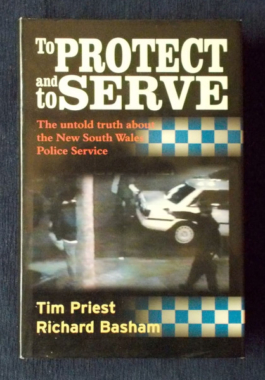 Almost every month in New South Wales, there are reports of police corruption and a police service under attack, from the criminals it tries to put away and the people it tries to protect and serve. Are the reports mere media sensationalism, or is the New South Wales Police in serious trouble? And if so, where did it go wrong? Priest was a cop who loved his job and gave everything he had to fight crime on the drug-ridden streets of Cabramatta. Yet he found his biggest battle was not with the drug gangs but with the very service he worked for. Eventually he could stand it no longer and spoke out about the bizarre policy decisions, politics, bureaucratic bungling and chronic lack of resources. For this he was labelled a whistle-blower and ultimately railroaded out of the police force. Yet a parlimentary enquiry and the testimony of other officers proved that Tim was not only telling the truth, but this was only the tip of the iceberg of what is really wrong with the New South Wales Police Force. While crime continues to spiral out of control, morale plummets among the rank and file police and experienced cops find they are at the mercy of a promotion system that leaves them nowhere to go but out. Tim teams up with Richard Basham, a man of vast experience through his involvement in a number of advisory boards, criminal investigations and personal friendships with ordinary cops, to reveal the untold story of the police service.
Almost every month in New South Wales, there are reports of police corruption and a police service under attack, from the criminals it tries to put away and the people it tries to protect and serve. Are the reports mere media sensationalism, or is the New South Wales Police in serious trouble? And if so, where did it go wrong? Priest was a cop who loved his job and gave everything he had to fight crime on the drug-ridden streets of Cabramatta. Yet he found his biggest battle was not with the drug gangs but with the very service he worked for. Eventually he could stand it no longer and spoke out about the bizarre policy decisions, politics, bureaucratic bungling and chronic lack of resources. For this he was labelled a whistle-blower and ultimately railroaded out of the police force. Yet a parlimentary enquiry and the testimony of other officers proved that Tim was not only telling the truth, but this was only the tip of the iceberg of what is really wrong with the New South Wales Police Force. While crime continues to spiral out of control, morale plummets among the rank and file police and experienced cops find they are at the mercy of a promotion system that leaves them nowhere to go but out. Tim teams up with Richard Basham, a man of vast experience through his involvement in a number of advisory boards, criminal investigations and personal friendships with ordinary cops, to reveal the untold story of the police service. -
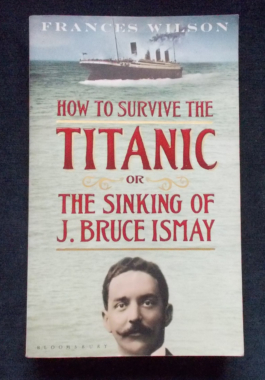
Or, The Sinking of J. Bruce Ismay. When the ship hit an iceberg on 14 April, 1912 and a thousand men prepared to die, J, Bruce Ismay, the ship's owner, jumped into a lifeboat with the women and children and rowed away to safety. Accused of cowardice, Ismay became the first victim of a press hate campaign. His reputation would never recover and while other survivors were piecing together their accounts of the night, Ismay never spoke of his beloved ship again. So what really went on? Was there a cover-up, or an attempt to prevent surviving crew members from testifying? A very in-depth study of the troubled Ismay from his childhood until his death. A must-have for any Titanic buff. Illustrated with black and white photographs.
-
 This history is a concise introduction to the great developments in aviation from its origins to modem times. The splendid and classic achievements of Sir George Cayley, Otto Lilienthal, the Wright brothers and the many other pioneers are engrossingly portrayed. The importance of the two world wars to the aviation story is recognized and a chapter is devoted to each. The reader is brought up to date with innovations such as the Soviet MiG-25 Foxbat, the Rockwell International B-1 bomber, the largest variable-geometry aircraft flying, and the Panavia Tornado and the F-16, the fighters of the 1980s. Lavishly illustrated with many historic photographs.
This history is a concise introduction to the great developments in aviation from its origins to modem times. The splendid and classic achievements of Sir George Cayley, Otto Lilienthal, the Wright brothers and the many other pioneers are engrossingly portrayed. The importance of the two world wars to the aviation story is recognized and a chapter is devoted to each. The reader is brought up to date with innovations such as the Soviet MiG-25 Foxbat, the Rockwell International B-1 bomber, the largest variable-geometry aircraft flying, and the Panavia Tornado and the F-16, the fighters of the 1980s. Lavishly illustrated with many historic photographs. -
 Joyce Grenfell is best known here for her galumphing, naive gym teacher portrayals in the first St Trinians film series, yet she was so much more than that. A character actress in many films, star of stage and radio, she travelled the world and visited Australia several times, always to a warm reception from her fans. She was a keen charity worker and Christian Scientists through faith, not fashion and never tried to force her beliefs on anyone around. Here she describes her joy in the world around her, whether it be a ride on the Sydney ferry, birdwatching in Queensland or badgerwatching in Cumberland. She always found joy in the world and people around her.
Joyce Grenfell is best known here for her galumphing, naive gym teacher portrayals in the first St Trinians film series, yet she was so much more than that. A character actress in many films, star of stage and radio, she travelled the world and visited Australia several times, always to a warm reception from her fans. She was a keen charity worker and Christian Scientists through faith, not fashion and never tried to force her beliefs on anyone around. Here she describes her joy in the world around her, whether it be a ride on the Sydney ferry, birdwatching in Queensland or badgerwatching in Cumberland. She always found joy in the world and people around her. -

More Morley: Robert Morley
$20.00Robert Morley CBE (1908 - 1992) was not only a very fine character actor; he was also blessed with a rollicking schoolboy humour of the goodies of life. He was one of those rare creatures who could write and had a sense of humour about himself. In this collection of writings he explored -again - the stylish vein of urbane self mockery which he revealed in A Musing Morley and Morley Marvels. He reminisces about his early life and acting career; the eccentricities of his nearest and sometimes dearest; presents gossipy accounts of his day to day preoccupations; airs his prejudices and vents his grievances; lets his imagination soar in baroque flights of fancy and recalls adventures from abroad and at home. In a long and illustrious career in film and stage, he was known for his role of Louis XVI in Marie Antionette; George III in Beau Brummel; Max Vandeveer in Who Is Killing the Great Chefs of Europe? and many more classic dramas and comedies. -
 Hollywood hunk and swash-buckler Stewart Granger tells of his leap to stardom in The Man In Grey and his overnight Hollywood success in King Solomon's Mines. He battled studio bosses, including Howard Hughes, experienced near-fatal accidents in film stunts that he always insisted on doing himself and had very close encounters with wild animals while filming in Africa and India - not to mention the temptation of being thrown together with some of the most beautiful women in the world. This iconic actor tells his story his way -with frankness, modesty and homeliness. Known for heroic sword fighting-roles such as The Prisoner of Zenda and Beau Brummell, Granger says: "I always thought I was big until I played opposite John Wayne in North to Alaska!"
Hollywood hunk and swash-buckler Stewart Granger tells of his leap to stardom in The Man In Grey and his overnight Hollywood success in King Solomon's Mines. He battled studio bosses, including Howard Hughes, experienced near-fatal accidents in film stunts that he always insisted on doing himself and had very close encounters with wild animals while filming in Africa and India - not to mention the temptation of being thrown together with some of the most beautiful women in the world. This iconic actor tells his story his way -with frankness, modesty and homeliness. Known for heroic sword fighting-roles such as The Prisoner of Zenda and Beau Brummell, Granger says: "I always thought I was big until I played opposite John Wayne in North to Alaska!" -
 The Granny on the Roof-rack...and other tales of modern horror. Over 100 contemporary Australian legends reproduced just as they spread via word-of-mouth, the media, social media and the Internet. The stories range from the funny, to the bizarre and definitely to the terrifying. Told with tongue in cheek and a large grain of salt, topics included in this volume: The Baby In The Microwave; An Elephant On The Mini; The Frozen Chook At The Checkout; Kid(ney) Napping; and of course, the infamous Granny On The Roofrack.
The Granny on the Roof-rack...and other tales of modern horror. Over 100 contemporary Australian legends reproduced just as they spread via word-of-mouth, the media, social media and the Internet. The stories range from the funny, to the bizarre and definitely to the terrifying. Told with tongue in cheek and a large grain of salt, topics included in this volume: The Baby In The Microwave; An Elephant On The Mini; The Frozen Chook At The Checkout; Kid(ney) Napping; and of course, the infamous Granny On The Roofrack. -
 A book by H. V. Morton is more than a travel book: it is a sensitive interpretation of a country's people and their history. The success of his first book on England, established the popularity of something new and refreshing in this type of literature. Mr Morton's travels have gained him thousands of readers in all parts of the world. The author has frequently been requested to define the secret of writing a travel book. He always replies: 'There is no secret. You either enjoy yourself or you do not. If you do, say so; if you do not - say so.' This disarming sincerity is, perhaps, responsible for the charm and fascination of his books. The feel and smell of the countryside, also a sense of movement, find their way into these light-hearted wanderings, and, combined with humour, acute observation, sympathy and an engaging curiosity, have justly gained for them a wide and increasing popularity. Contents Include: I Go In Search of Scotland - I Explore Edinburgh - I See The Castle Of Roslin - Tells How I Go On Through Rain To Lochleven - In Which I Climb Into The Highlands - I Describe A Mystery Of Aberdeen - Describes A Sincere Scottish Breakfast - In Which I Work East To West - I Go By Sea to Skye - How I Break The Sabbath - I Sail Up The Clyde Into Glasgow - In Which I Encounter Men Who Melt Steel. Illustrated with black and white photographs.
A book by H. V. Morton is more than a travel book: it is a sensitive interpretation of a country's people and their history. The success of his first book on England, established the popularity of something new and refreshing in this type of literature. Mr Morton's travels have gained him thousands of readers in all parts of the world. The author has frequently been requested to define the secret of writing a travel book. He always replies: 'There is no secret. You either enjoy yourself or you do not. If you do, say so; if you do not - say so.' This disarming sincerity is, perhaps, responsible for the charm and fascination of his books. The feel and smell of the countryside, also a sense of movement, find their way into these light-hearted wanderings, and, combined with humour, acute observation, sympathy and an engaging curiosity, have justly gained for them a wide and increasing popularity. Contents Include: I Go In Search of Scotland - I Explore Edinburgh - I See The Castle Of Roslin - Tells How I Go On Through Rain To Lochleven - In Which I Climb Into The Highlands - I Describe A Mystery Of Aberdeen - Describes A Sincere Scottish Breakfast - In Which I Work East To West - I Go By Sea to Skye - How I Break The Sabbath - I Sail Up The Clyde Into Glasgow - In Which I Encounter Men Who Melt Steel. Illustrated with black and white photographs. -
 Vivien Leigh won international acclaim at the age of twenty-six when she crossed the Atlantic and walked off with the coveted part of Scarlett O'Hara in Gone with the Wind under the noses of some of Hollywood's most famous stars. For this part alone she has earned a lasting place in film history. Loved by millions, Vivien had a illustrious stage and screen career that spanned thirty years. She triumphed in such diverse roles as Blanche Dubois in A Streetcar Named Desire and Cleopatra, playing opposite her husband Laurence Olivier. She was a complex and driven personality, a brilliant actress whose terrifying dips into manic depression were little understood by those around here. This is no 'Hollywood' filmography, but an intensely researched biography that includes Vivien Leigh's parents and a detailed history of her relationship with Leigh Holman. Of course, her love for Laurence Olivier and their twenty year marriage is covered, so much of it made difficult by recurring bouts of tuberculosis and manic depression. Vickers, drawing on many hours of conversation with her devoted friend, the actor John Merivale, explained how Vivien re-established her life after the divorce. Illustrated with black and white photographs.
Vivien Leigh won international acclaim at the age of twenty-six when she crossed the Atlantic and walked off with the coveted part of Scarlett O'Hara in Gone with the Wind under the noses of some of Hollywood's most famous stars. For this part alone she has earned a lasting place in film history. Loved by millions, Vivien had a illustrious stage and screen career that spanned thirty years. She triumphed in such diverse roles as Blanche Dubois in A Streetcar Named Desire and Cleopatra, playing opposite her husband Laurence Olivier. She was a complex and driven personality, a brilliant actress whose terrifying dips into manic depression were little understood by those around here. This is no 'Hollywood' filmography, but an intensely researched biography that includes Vivien Leigh's parents and a detailed history of her relationship with Leigh Holman. Of course, her love for Laurence Olivier and their twenty year marriage is covered, so much of it made difficult by recurring bouts of tuberculosis and manic depression. Vickers, drawing on many hours of conversation with her devoted friend, the actor John Merivale, explained how Vivien re-established her life after the divorce. Illustrated with black and white photographs. -
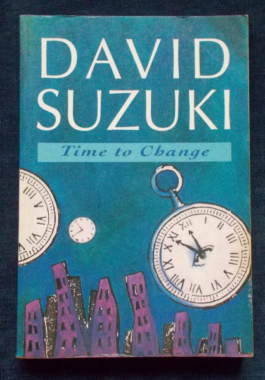
Time To Change: David Suzuki
$10.00The 1990s were not only a time of change; they were also the time when we needed to change. The signs are everywhere - garbage clogging the cities; the pollution of the world's waterways; global warming; polluted air; countries with too many people and too little food; and the vanishing forever of species. Suzuki calls out attention to the signs then considers the the realms of science, politics and economics to find the source of our problems as well as the ground on which we can - and cannot - place our hopes for the future. With his customary no-nonsense response, he lays bare our comfortable assumptions and takes a hard look at some modern conundrums before revealing our hope for the future. -
 Anthony Trollope's claim that Aussies were great boasters and blowers was refuted by the author in 1883: "Ah, dear Mr. Trollope! Let them have their say. They are not so far wrong after all, for no country in the world, not even in America in proportion to its population, can show such astonishing progress...in the last quarter of a century...They are a young people with the faults of youth..." Originally published in 1883, La Meslee saw what Australian and English eyes missed or merely took for granted about the new colony. Melbourne Cup Day; a politician's maiden speech; a coach journey along what is now the Hume Highway; the meeting of two French Counts in Townsville - all these events and more are brought to life again, presenting a fascinating picture of a developing society full of vitality and brash self-confidence. Illustrated with beautiful black and white sketches.
Anthony Trollope's claim that Aussies were great boasters and blowers was refuted by the author in 1883: "Ah, dear Mr. Trollope! Let them have their say. They are not so far wrong after all, for no country in the world, not even in America in proportion to its population, can show such astonishing progress...in the last quarter of a century...They are a young people with the faults of youth..." Originally published in 1883, La Meslee saw what Australian and English eyes missed or merely took for granted about the new colony. Melbourne Cup Day; a politician's maiden speech; a coach journey along what is now the Hume Highway; the meeting of two French Counts in Townsville - all these events and more are brought to life again, presenting a fascinating picture of a developing society full of vitality and brash self-confidence. Illustrated with beautiful black and white sketches. -
 "Learn all you can about the German Army and one day you will be a valuable man to your country." These words were spoken to young Alexander Scotalnd by Major Wade, a British liaison officer in German West Africa in 1904. He never forgot those words. This book covers how much he learnt and how valuable were his services to his country. This young man served in the German Army - at the suggestion of the Germans - for the duration of the Hottentot Rebellion, thereby gaining an intimate knowledge of the organisation and strengths of the German military machine. He grew to know, by close contact, the habits, language and mental outlook of the German soldier. This knowledge was the basis of his achievements in espionage, interrogation and undercover work in two world wars. His reputation led to a strange meeting with Adolf Hitler in 1937, at the home of a mutual friend. His career reached its zenith in 1947 when - as Chief Officer of the War Crimes Investigation Unit, he played a decisive role in bringing Nazi war criminals to justice. Illustrated with black and white photographs.
"Learn all you can about the German Army and one day you will be a valuable man to your country." These words were spoken to young Alexander Scotalnd by Major Wade, a British liaison officer in German West Africa in 1904. He never forgot those words. This book covers how much he learnt and how valuable were his services to his country. This young man served in the German Army - at the suggestion of the Germans - for the duration of the Hottentot Rebellion, thereby gaining an intimate knowledge of the organisation and strengths of the German military machine. He grew to know, by close contact, the habits, language and mental outlook of the German soldier. This knowledge was the basis of his achievements in espionage, interrogation and undercover work in two world wars. His reputation led to a strange meeting with Adolf Hitler in 1937, at the home of a mutual friend. His career reached its zenith in 1947 when - as Chief Officer of the War Crimes Investigation Unit, he played a decisive role in bringing Nazi war criminals to justice. Illustrated with black and white photographs. -
 As we crowded the decks off Gallipoli and watched the first shells crash into Turkish soil... Trooper Ion L. Idriess of the 5th Australian Light Horse began keeping a diary. Over the next three years as the regiment moved onto Palestine, stormed Beersheba and pushed into the Sinai, his diary grew and became one of the most vivid pieces of war narrative ever written. Unconcerned with grand strategy or moralisations, Idriess records the realities of his war - maggot-ridden trenches crowded with the corpses of his mates, the good friendships, the bad tucker, the heat, the dust, the boredom of desert patrols - and always the fighting and his reactions to it, which reveal far better than mere description, since he was there. The rifle fire grew to a roar that drowned the voice of the man next to me. I felt as a stone age man might feel if volcanoes all around him suddenly spat life and roared...Believed to be Idriess' earliest work.
As we crowded the decks off Gallipoli and watched the first shells crash into Turkish soil... Trooper Ion L. Idriess of the 5th Australian Light Horse began keeping a diary. Over the next three years as the regiment moved onto Palestine, stormed Beersheba and pushed into the Sinai, his diary grew and became one of the most vivid pieces of war narrative ever written. Unconcerned with grand strategy or moralisations, Idriess records the realities of his war - maggot-ridden trenches crowded with the corpses of his mates, the good friendships, the bad tucker, the heat, the dust, the boredom of desert patrols - and always the fighting and his reactions to it, which reveal far better than mere description, since he was there. The rifle fire grew to a roar that drowned the voice of the man next to me. I felt as a stone age man might feel if volcanoes all around him suddenly spat life and roared...Believed to be Idriess' earliest work. -
 The Lord puts the salmon in the river like he puts the berries on the trees. They're there for all of us, not just for the laird. The way the Bruachites see it, poaching wasn't a crime, even if you had to keep an eye out for the police. It was more like a natural right. And Fishermen Erchy and Hector are the experts, but they are not the only ones tempted - even a visiting vicar succumbs to the temptation of the fat salmon that fill the island's streams and pools. Like her other four collections of tales about her eccentric island friends, Lillian Beckwith gives us the funny side of many a unique adventure.
The Lord puts the salmon in the river like he puts the berries on the trees. They're there for all of us, not just for the laird. The way the Bruachites see it, poaching wasn't a crime, even if you had to keep an eye out for the police. It was more like a natural right. And Fishermen Erchy and Hector are the experts, but they are not the only ones tempted - even a visiting vicar succumbs to the temptation of the fat salmon that fill the island's streams and pools. Like her other four collections of tales about her eccentric island friends, Lillian Beckwith gives us the funny side of many a unique adventure. -
 Cat; n. Small domesticated carnivorous quadruped. This selection of writings has been presented as Nine Lives: The Kittenish; The Legendary; The Traditional; The Diabolical; The Poetical; The Domestic; The Curious; The Wild and The Last. A fabulous vintage volume for those who worship and observe cats. Illustrated with black and white photographs.
Cat; n. Small domesticated carnivorous quadruped. This selection of writings has been presented as Nine Lives: The Kittenish; The Legendary; The Traditional; The Diabolical; The Poetical; The Domestic; The Curious; The Wild and The Last. A fabulous vintage volume for those who worship and observe cats. Illustrated with black and white photographs. -
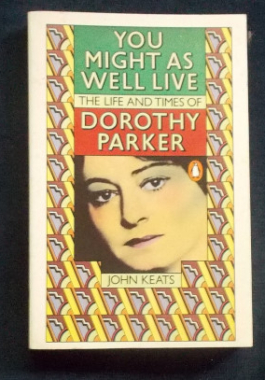 'How could they tell?' inquired Dorothy Parker when it was announced that president Coolidge had died. Her serpent tongue was notorious in the age of F. Scott Fitzgerald and Hemingway. gay, attractive, crackling with talent, Dorothy Parker starred in the most famous literary circle of the day. In verse, in New Yorker reviews, in lightning wisecracks, she cut everyone down to her own five feet. This is a recapturing of the extraordinary woman who lived and drank in splendour, loved in snatches, practised suicide and died alone in squalor. Beyond the wit abd glitter, the story is sad yet brave.
'How could they tell?' inquired Dorothy Parker when it was announced that president Coolidge had died. Her serpent tongue was notorious in the age of F. Scott Fitzgerald and Hemingway. gay, attractive, crackling with talent, Dorothy Parker starred in the most famous literary circle of the day. In verse, in New Yorker reviews, in lightning wisecracks, she cut everyone down to her own five feet. This is a recapturing of the extraordinary woman who lived and drank in splendour, loved in snatches, practised suicide and died alone in squalor. Beyond the wit abd glitter, the story is sad yet brave. -
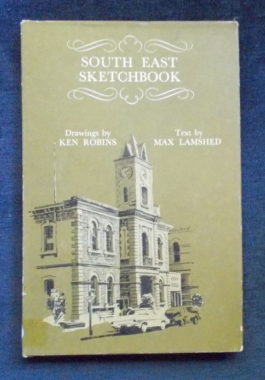 The South East of South Australia was settled by pioneers who drove their stock from east or west and by those who landed at the tiny ports on the rocky coast. Within a few years, huge pastoral properties had been established and big cargoes of primary produce were being shipped out through Robe. The governor had a summer residence there; it was a busy social centre and thousands of Chinese began their march to the goldfields from its beaches. Sea traffic dwindled when the railway came, inland towns flourished and Mount Gambier, Naracoote and Millicent became more important than the seaports. When engineers broke through ‘Narrow Neck’ and began draining the swamps, great areas of land for farming opened up. Winemaking and forestry thrived and played their part in making the South East one of the state’s richest areas.
The South East of South Australia was settled by pioneers who drove their stock from east or west and by those who landed at the tiny ports on the rocky coast. Within a few years, huge pastoral properties had been established and big cargoes of primary produce were being shipped out through Robe. The governor had a summer residence there; it was a busy social centre and thousands of Chinese began their march to the goldfields from its beaches. Sea traffic dwindled when the railway came, inland towns flourished and Mount Gambier, Naracoote and Millicent became more important than the seaports. When engineers broke through ‘Narrow Neck’ and began draining the swamps, great areas of land for farming opened up. Winemaking and forestry thrived and played their part in making the South East one of the state’s richest areas. -
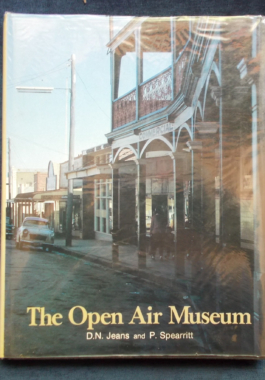 A volume covering the cultural landscape of New South Wales through how and what we built, and the importance of preserving the examples of architecture we can before development and demolition removes them forever: the evolution of our architecture; how economic development via immigration and capital inflow played a role; the influence of the pastoral, wheat and dairy industries; the growth and decline of country towns; how the railways, road building and transport altered the where and when of accommodation establishments; the proliferation of the colliery towns - and how Sydney went from being a town to being a city. Black and white photographs.
A volume covering the cultural landscape of New South Wales through how and what we built, and the importance of preserving the examples of architecture we can before development and demolition removes them forever: the evolution of our architecture; how economic development via immigration and capital inflow played a role; the influence of the pastoral, wheat and dairy industries; the growth and decline of country towns; how the railways, road building and transport altered the where and when of accommodation establishments; the proliferation of the colliery towns - and how Sydney went from being a town to being a city. Black and white photographs. -
 The first successful north-south automobile crossing of Australia took place in 1908 - a carefully organised and expensive venture. Over the next two decades there were not many other successful crossings. Such transcontinental crossings were made by following the Overland Telegraph Line or the railways extending north from Port Augusta and south from Darwin. In 1929, after four years of severe drought, two cars left separately for Darwin via the bush track which was the 'main road' across the continent - a large Vauxhall 23/60 carrying a married couple in their early thirties and six weeks alter, an Austin Seven driven by a lone eighteen-year-old Englishman. The Vauxhall made Darwin safely; the Austin struggled on to Daly Waters and reached there, unable to continue, on the day the Vauxhall (on its return journey south) arrived. The exhausted Penryn Goldman abandoned 'Baby' and travelled back with the Wrights in 'Vauxie'. Frank Wright kept a daily diary and both he and his wife were keen photographers. Penryn Goldman later published a book of his Australian adventures. Winty Calder, Frank and Win Wright's daughter has merged both of these accounts and many photographs to give graphic insights into the pre-World War II conditions of inland Australia to present a part of history when Australian tourism was in its infancy. With black and white photographs.
The first successful north-south automobile crossing of Australia took place in 1908 - a carefully organised and expensive venture. Over the next two decades there were not many other successful crossings. Such transcontinental crossings were made by following the Overland Telegraph Line or the railways extending north from Port Augusta and south from Darwin. In 1929, after four years of severe drought, two cars left separately for Darwin via the bush track which was the 'main road' across the continent - a large Vauxhall 23/60 carrying a married couple in their early thirties and six weeks alter, an Austin Seven driven by a lone eighteen-year-old Englishman. The Vauxhall made Darwin safely; the Austin struggled on to Daly Waters and reached there, unable to continue, on the day the Vauxhall (on its return journey south) arrived. The exhausted Penryn Goldman abandoned 'Baby' and travelled back with the Wrights in 'Vauxie'. Frank Wright kept a daily diary and both he and his wife were keen photographers. Penryn Goldman later published a book of his Australian adventures. Winty Calder, Frank and Win Wright's daughter has merged both of these accounts and many photographs to give graphic insights into the pre-World War II conditions of inland Australia to present a part of history when Australian tourism was in its infancy. With black and white photographs. -

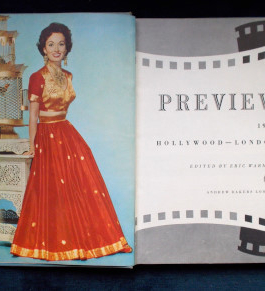 A teaser of the upcoming movie attractions of 1957, with interviews and photos of the great and sadly, some now forgotten as well as details of the films in production. There's on-set candid shots as well as glamour pics, with plenty for the vintage film enthusiast: Jack Lemmon, John Wayne; Jean Simmons, Marilyn Monroe, Joan Collins, Doris Day, a young Benny Hill and many more. Film previews include The Battle Of The River Plate, The Spirit Of St. Louis, Giant, Kismet and more. Illustrated with numerous colour and black and white photographs.
A teaser of the upcoming movie attractions of 1957, with interviews and photos of the great and sadly, some now forgotten as well as details of the films in production. There's on-set candid shots as well as glamour pics, with plenty for the vintage film enthusiast: Jack Lemmon, John Wayne; Jean Simmons, Marilyn Monroe, Joan Collins, Doris Day, a young Benny Hill and many more. Film previews include The Battle Of The River Plate, The Spirit Of St. Louis, Giant, Kismet and more. Illustrated with numerous colour and black and white photographs. -
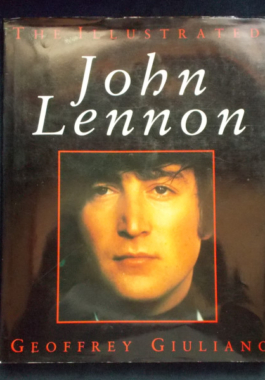 Noted celebrity biographer Giuliano and his literary partner Brenda take the reader beyond any of the two dozen plus books about the dreamy, bespectacled singer/composer from Liverpool. With text culled from over a decade of painstaking research in Lennon's extraordinary life, this insightful look at the former Beatle's life is rounded out with a treasury of sledo seen and some never-before published photographs spanning Lennon's entire life. There is also an introduction from Charlie Lennon, John's uncle, who reveals the often complicated inner world of his famous nephew.
Noted celebrity biographer Giuliano and his literary partner Brenda take the reader beyond any of the two dozen plus books about the dreamy, bespectacled singer/composer from Liverpool. With text culled from over a decade of painstaking research in Lennon's extraordinary life, this insightful look at the former Beatle's life is rounded out with a treasury of sledo seen and some never-before published photographs spanning Lennon's entire life. There is also an introduction from Charlie Lennon, John's uncle, who reveals the often complicated inner world of his famous nephew. -
 In 1762 James Boswell, then twenty-two years old, left Edinburgh for London. The famous Journal he kept during the next nine months is an intimate account of his encounters with the high-life and the low-life in London. Frank and confessional as a personal portrait of the young Boswell, the Journal is also revealing as a vivid portrayal of life in eighteenth-century London. This new edition includes an introduction by Peter Ackroyd, which discusses Boswell’s life and achievement. From the introduction: Boswell was the most charming companion in the world, and London becomes his dining-room and his playground, his club and his confessional. No celebrant of the London world can ignore his book.
In 1762 James Boswell, then twenty-two years old, left Edinburgh for London. The famous Journal he kept during the next nine months is an intimate account of his encounters with the high-life and the low-life in London. Frank and confessional as a personal portrait of the young Boswell, the Journal is also revealing as a vivid portrayal of life in eighteenth-century London. This new edition includes an introduction by Peter Ackroyd, which discusses Boswell’s life and achievement. From the introduction: Boswell was the most charming companion in the world, and London becomes his dining-room and his playground, his club and his confessional. No celebrant of the London world can ignore his book.


